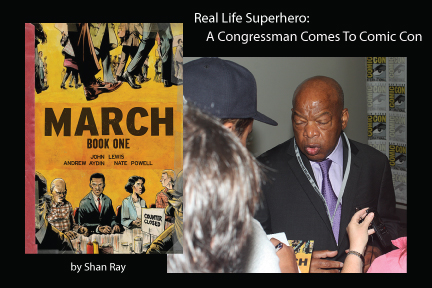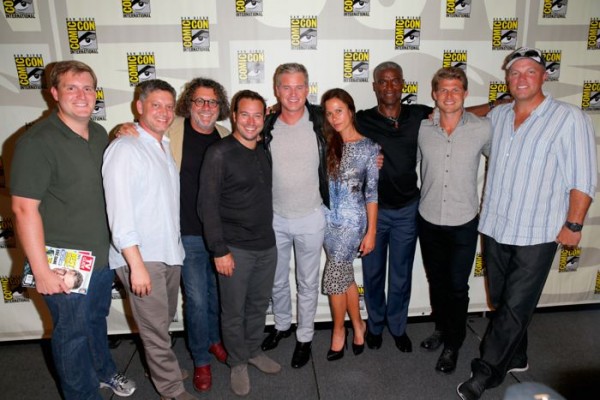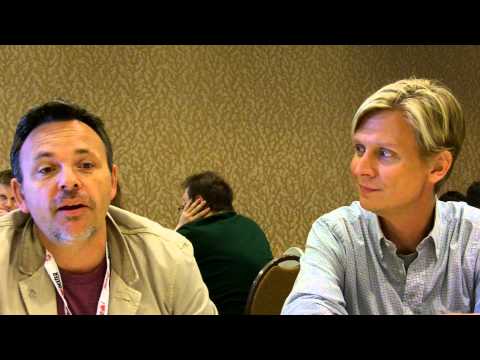 July 20, 2013, SDCC- Room 23ABC
July 20, 2013, SDCC- Room 23ABC
Comic book superheroes have super powers. Real heroes don’t. Super heroes defy gravity and bounce off tall buildings in pursuit of monsters. Real heroes are grounded and walk on feet with bunions. Super heroes battle seemingly insurmountable forces and win through with some collateral damage to the landscape. Real heroes quietly survive beatings, fire hoses and attack dogs, and, after getting out of the hospital, still march on to Washington in the heat of summer.
In the wild costumed halls of Comic Con, a congressman in a grey suit that is not a Dr. Who suit stands out in the colorful crowd. The early Saturday session already had a line an hour before the panel and once in, the room was packed to the rafters, people lining the walls in defiance of the fire code. John Lewis appeared by the doors and was immediately surrounded by people. On the dais, he was greeted by a standing ovation. He was at Comic Con to promote a comic book, a graphic novel, called March, which hit the stores August 13, and is currently the number one bestselling graphic novel on Amazon. The idea germinated in 2008. Congressional aide and writer Andrew Aydin and Congressman Lewis took 5 years to write the book’s script, and Nate Powell rendered the black and white washes to reflect a time not in the colors of the present.
 The inspiration for March came in part from a small newsprint comic book called Martin Luther King and The Montgomery Story, which was published as a guide to non-violent protest. That 10-cent comic book has since been reprinted in many languages and found its way into many other countries like Vietnam and, most recently, distributed in Tahrir Square at the start of the Arab Spring in 2011. It has been translated into Arabic and Farsi, and probably doesn’t cost 10 cents anymore. But the humble newsprint comic that inspired an earlier generation and the Civil Rights movement was still inspiring current generations in different countries where civil and human rights battles still rage today in the new forms of gay rights, voting rights and the Dreamers of Immigration Reform. “Comic books,” said Andrew Aydin, “can change the world.”
The inspiration for March came in part from a small newsprint comic book called Martin Luther King and The Montgomery Story, which was published as a guide to non-violent protest. That 10-cent comic book has since been reprinted in many languages and found its way into many other countries like Vietnam and, most recently, distributed in Tahrir Square at the start of the Arab Spring in 2011. It has been translated into Arabic and Farsi, and probably doesn’t cost 10 cents anymore. But the humble newsprint comic that inspired an earlier generation and the Civil Rights movement was still inspiring current generations in different countries where civil and human rights battles still rage today in the new forms of gay rights, voting rights and the Dreamers of Immigration Reform. “Comic books,” said Andrew Aydin, “can change the world.”
When the book’s script was turned over to Nate Powell, it was supposed to be a 150-200 page graphic novel. After Nate began to break the script down into pages, covering the tension and emotion so evident in the novel, “I was looking at a 500-page novel,” he said. The congressman gave the new length his blessing when he said, “Just go ahead and make it a trilogy.” Part 2 will be released in 2014 and Part 3 in 2015. I warn you because at the end of Part 1, you are left wanting more, and this is a longer wait than an end-of-season cliffhanger.
The comic devotes some time to John Lewis’ young boyhood, the son of a sharecropper, who was in charge of the farm chickens and egg collection. Chickens that, the congressman pointed out, were certainly more productive than the current 113th Congress. After the short Q&A, another crowd gathered around the congressman, and he spoke with everyone, shaking hands, taking pictures. Not a few people walked away surreptitiously wiping their eyes. There were surprising and powerful emotions in that room, and in the line at Top Shelf Productions where the books were flying off the table to be signed by Nate, Andrew and John Lewis. “A real life Superhero” was a phrase heard often around Top Shelf’s signing table that day.
 On the back cover of the book is a note from President Bill Clinton, a first presidential review for a comic book: “In March, he brings a whole new generation with him across the Edmund Pettis Bridge, from a past of clenched fists into a future of outstretched hands.”
On the back cover of the book is a note from President Bill Clinton, a first presidential review for a comic book: “In March, he brings a whole new generation with him across the Edmund Pettis Bridge, from a past of clenched fists into a future of outstretched hands.”
The 50th anniversary of the March on Washington is Wednesday August 28th, a day famous for a speech that changed a nation. The pages of a humble comic book is where the march had its beginnings, bringing John Lewis and so many others from the unpaved farm roads and segregated lunch counters of the Deep South, across the Edmund Pettis Bridge in Selma, Alabama to the Washington Monument, where the 50th anniversary is celebrated in the glare of the hot August sun, the media, cellphone cameras and Twitter feeds.
Comics can change the world.











